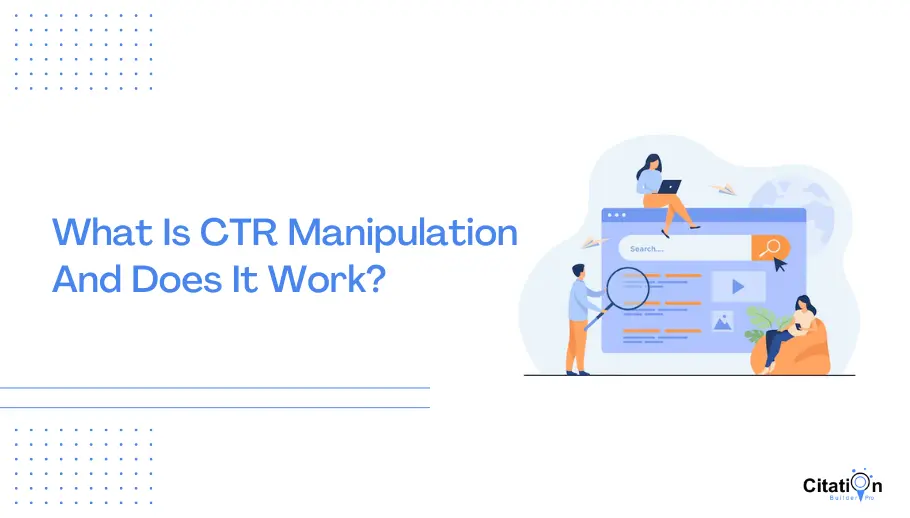Master CTR Manipulation to Skyrocket Your Click-Through Rates
Comprehending the nuances of click-through rate (CTR) adjustment is important for any kind of digital advertising strategy focused on enhancing engagement and driving conversions. By using psychological triggers such as inquisitiveness and deficiency, marketing experts can craft material that not just captures attention but compels action. However, the performance of these strategies depends upon a solid foundation of well-structured headlines and maximized visuals. As we discover the details of these aspects, you might wonder just how to execute these techniques properly and what common mistakes to avoid.
Understanding Click-Through Price
Click-Through Price (CTR) is a critical metric in electronic advertising that evaluates the efficiency of on-line campaigns. It stands for the percent of customers that click on a particular link out of the total number of users that view the material, such as an advertisement or an email. A higher CTR suggests that the content is reverberating with the audience, while a lower CTR might recommend a demand for improvement in messaging or targeting.

Comprehending CTR is essential for online marketers as it offers insights into customer engagement and the performance of different strategies. A well-optimized CTR can bring about raised traffic, much better conversion prices, and eventually, higher roi (ROI) For that reason, routine surveillance and analysis of CTR should be a basic practice for any type of digital advertising strategy, enabling online marketers to make data-driven decisions and enhance campaign efficiency.

Psychological Triggers for Clicks
Reliable digital marketing pivots not only on information analytics yet likewise on understanding the emotional triggers that compel users to engage with material. These triggers are rooted in cognitive biases and human emotions, producing paths for customers to act.
One effective emotional trigger is curiosity. They are a lot more most likely to click via to satisfy their inquisitiveness when customers experience web content that ignites their interest or poses a fascinating inquiry. In addition, the concept of shortage can drive seriousness; when users view that an offer is restricted, the worry of losing out (FOMO) usually propels them to click.
Social evidence is an additional substantial aspect, as people often tend to follow the actions of others. Highlighting testimonials or showcasing prominent content can develop trust and encourage clicks. The usage of vivid imagery and compelling visuals can stimulate feelings, making individuals a lot more inclined to engage.
Crafting Engaging Headlines
Headlines work as the gateway to your content, playing a crucial duty in attracting clicks and driving involvement. A well-crafted heading not just catches interest but also conveys the essence CTR Manipulation of your material succinctly. It serves as a guarantee to the reader, suggesting the value they will gain by clicking through.
To develop compelling headings, make use of action-oriented language that urges viewers to act. Strong verbs can impart necessity and excitement. Including checklists or numbers can boost clearness and provide a concrete takeaway, as in "5 Tips to Improve Your Click-Through Rate." Furthermore, posturing a concern can pique inquisitiveness, urging readers to look for answers within your content (CTR Manipulation Service).
Consider your target market and tailor your headings to reverberate with their passions and discomfort factors. A/B screening different headline formats can provide insight right into what resonates most efficiently, permitting consistent improvement. Lastly, stay clear of clickbait methods that may result in disillusionment; rather, guarantee that your headings accurately reflect the content they introduce. By grasping the art of headline crafting, you place your content for maximum presence and interaction, inevitably improving your click-through rates.
Enhancing Aesthetic Components
Visual aspects are indispensable to boosting individual engagement and boosting general content performance. Reliable use of photos, infographics, and video clips can dramatically raise the charm of your web content, attracting customers in and increasing click-through prices (CTR) To enhance these visual elements, start by guaranteeing they are high-grade and pertinent, as inadequate visuals can detract from your message and reduce customer interest.
Tactically placing visuals within your material is additionally vital. In addition, consider the usage of thumbnails for video clip web content; an interesting thumbnail can entice customers to click, driving up CTR.
Analyzing and Testing Strategies
Recognizing customer actions with methodical analysis and screening is crucial for grasping CTR adjustment. To effectively boost your click-through rates, it is important to use data-driven approaches that expose what resonates with your audience. Begin by examining historic performance metrics, determining patterns in individual interaction, and segmenting your target market based upon demographics and habits.
Implement A/B screening to compare various variants of your material, such as headings, imagery, and calls-to-action. This approach allows you to isolate variables and identify which components produce the highest possible interaction. Use tools like Google Analytics or Heatmaps to collect insights into user interactions, concentrating on locations that attract one of the most interest.
Furthermore, consider applying multivariate screening to evaluate several variables concurrently, giving a much more thorough understanding of user preferences. Monitor crucial efficiency indications like bounce prices and time on page to evaluate the performance of your techniques.
Conclusion
Mastering CTR control is essential for driving and boosting click-through prices engagement. By recognizing the ins and outs of customer actions and leveraging psychological triggers, web content can be crafted to reverberate efficiently with the target audience. Employing approaches such as compelling headlines, maximized visual components, and strenuous evaluation via A/B testing contributes to continual renovation. Eventually, these tactics finish in boosted traffic and conversion rates, strengthening their significance in effective electronic advertising campaigns.

When individuals run into material that piques their rate of interest or positions an appealing inquiry, they are a lot more most likely to click via to please their inquisitiveness. Effective use of infographics, photos, and video clips can considerably raise the charm of your material, drawing users in and increasing click-through prices (CTR) Additionally, consider the usage of thumbnails for video content; an interesting thumbnail can attract customers to click, driving up CTR.